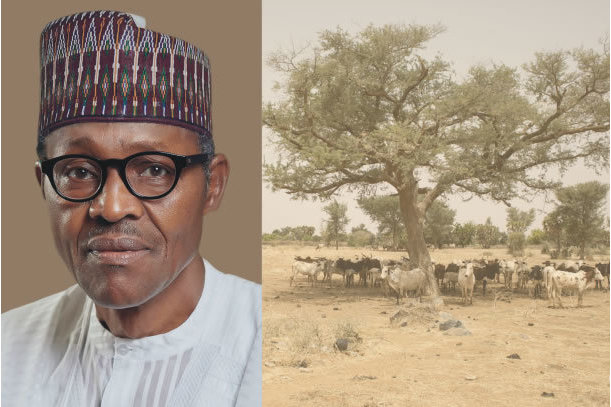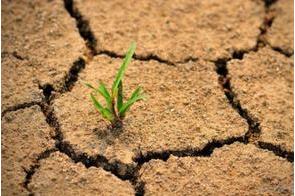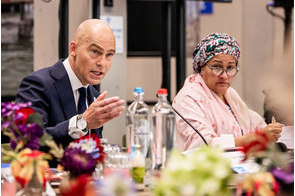Why Buhari's tree planting initiative should be reconsidered

Summary
To reduce the impact of climate change, tree planting does not necessarily have to be widespread in grassland.
President Muhammadu Buhari, in a recent article published in the prestigious Scientific American, outlined a proposal he had made at the United Nations Climate Summit in New York back in September for the planting of 25 million trees to combat climate change in Nigeria. The President said climate change has precipitated desert encroachment, pastoral conflicts and insecurity in the Sahel region of the country.
According to Buhari's article, titled, "Trees for Peace," the tree-planting initiative feeds into the Great Green Wall project, led by the African Union and funded by the World Bank, the European Union and the United Nations, and aimed at planting an 8,000-kilometre barrier of trees across the entire width of Africa, from Senegal to Djibouti. The trees would serve as a crucial carbon sink, removing carbon dioxide (CO2), a key greenhouse gas (GHG) that is associated with global warming.
The idea of planting trees is a fantastic approach to combating climate change. Forests help to sequester CO2 from the atmosphere. Forests also play other important ecological functions, including water and air purification and the maintenance of habitats for wildlife. They are also crucial for the livelihoods of millions of people in rural areas, according to a 2018 report by the Food and Agriculture Organisation of the United Nations (FAO). In fact, restoring forests is a top solution to climate change.
To underscore the perilous nature of the Sahel region, over 30 million people face food insecurity in the region – which stretches from northern Senegal, southern Mauritania, central Mali, northern Burkina Faso, the extreme south of Algeria, southern Niger, northeastern Nigeria, south-central Chad, and into The Sudan. According to a 2017 report by the UN, one in five children under the age of five suffers from acute malnutrition and at least 4.9 million are displaced by the effects of conflicts in the region.
Nevertheless, we must understand that forests are not more important than low-growing grasses and tall perennials, which constitute a major portion of the vegetation in the semiarid regions of Nigeria and other countries in the Sahel region. The region is known to support the growth of various types of forage crops like thorny shrubs, the acacia plant and baobab trees. Crops for human nutrition, such as millet and sorghum, are widely grown in the semiarid tropics of Africa, particularly in Nigeria, Mali and Niger.
These plants are also carbon sinks in their own right. A new research from the New Hampshire Agricultural Experiment Station at the University of New Hampshire in the United States, illustrates this important point. Although the research focuses on a temperate zone, it provides a critical lesson I would like to underscore in this article. The researchers found that perennial grasslands might be better suited than forests in tackling the effects of climate change, which is causing warmer winters.
The researches mounted environmental sensors above the forests and grassland to measure how much carbon dioxide goes in and out of the ecosystem. They found that the grassland took up about three times more carbon from the atmosphere during late winter/early spring than any other time of the year. This weather was more challenging for the forests because trees tend to lose their leaves during colder seasons. The conclusion of the study was that the grassland performed better as a carbon sink than forests during this period. Inferably, the ecosystem in our semiarid regions may have certain untapped potentials.
In as much as planting trees is a right step, making them grow in an area that is not their natural habitat like the Sahel is an attempt to rupture biodiversity. The push to increase the tree cover in an area that is predominantly grassland can also mean pushing out plants and species of animals that prefer open and spacious environments. Therefore, planting trees in large numbers in such places can become dangerous for these species, making it more difficult to defend themselves, while giving predators more protection.
More so, afforestation, the planting of trees in areas where they previously did not exist or on patches of unused and degraded land could be a misinterpreta-tion of the actual challenge, particularly in regressing or dormant areas like the situation in the Sahel. Some research findings have supported the fact that these regions that appear degraded house their own ecosystem that has developed over time. They may also be home to rare species of plants, which could be wiped out by the introduction of new trees.
Another aim of planting trees in the Sahel region of Nigeria, as stated by the President, is to solve conflicts between farmers and nomadic herders who migrate southward from the northern part of the country in search of water and green pasture for their cattle. I believe that the President is relying on the fact that trees, in the long run, can help to reduce the impact of climate change, which has exacerbated droughts in the region. But it bears saying that the tree planting initiative does not address the need to provide forage for cattle, given that they do not feed on trees. Therefore, addressing the farmers-herders conflict and the insecurity it poses requires a completely different strategy.
One approach to reducing the migration of nomadic herdsmen to the south and preventing conflicts with farmers is for the government to look into sustainable grassland production techniques as an attempt to manage pasture in semiarid areas of the country. Apart from being the fallout of climate change, the loss of pasture is also caused by overgrazing. Overgrazing reduces plant productivity, causes animals to run short of pasture and is one of the causes of desertification.
To reduce the impact of climate change, tree planting does not necessarily have to be widespread in grassland. Instead, we should look to growing more trees in areas that are known to be their natural habitat. In this case, reforestation might be the answer. By reforestation, I mean restoring the natural forests that civilization, population growth, farming and industrialization have depleted. Restoring natural forests permanently in the country and across the continent will provide much bigger carbon sinks for GHGs.
Reforestation plans, if implemented by the government, would need to be supported with Sustainable Forest Management (SFM) plans that optimise the contributions of forests to food security and societal needs. These needs would include conserving forest ecosystems for future generations. The government should enforce SFM laws, regulations and policies for forest conservation and environmental protection.
Conservation of forests should be taken more seriously because new trees grown to atone for deforestation may never create the exact ecosystem formed by trees that existed for hundreds of years before they were cleared. New trees may require that much time to catch up, in terms of restoring the lost ecosystem.
But despite the huge benefits of planting trees, we cannot put the burden of saving our planet entirely on trees. Whether we like it or not, it is our responsibility as humans to find ways to reduce our individual and collective GHG emissions. Individuals can also contribute their quota to tree planting projects by growing trees in their gardens and around their homes or other locations. Caution must be taken with regard to the species to plant, bearing in mind how big they would grow to become, and the potential for the roots to damage the foundations of buildings and other structures in the neighbourhood.
Permissions from land owners or local councils should be sought and adhered to. As rightly stated by the President, tree planting should be approached in an organised manner.
In conclusion, biodiversity is a big deal for our planet and should be maintained in our struggle to cut carbon emissions. As we make efforts to conserve the forest ecosystem and grow more trees to replenish this multipurpose natural resource, we must also ensure that the ecosystem in grasslands is conserved. Sustainable management of forests and sustainable grassland production can provide solutions both directly and indirectly to our present challenges of conflicts, food insecurity and biodiversity loss.
Financial Nigeria Columnist, Mojisola Karigidi, is a Nigerian biochemist and the founder and product developer at Moepelorse Bio Resources. She is also a Global Innovation Through Science and Technology (GIST) awardee, and an Aspen New Voices fellow.
Related
-
Scientists say 2018 was fourth warmest year on record since 1850
According to the Berkeley Earth’s report, 2019 is expected to be warmer than 2018.
-
World leaders advocate support for climate adaptation for Africa
Africa needs to invest massively in adaptation and resilience – President Macky Sall.
-
Climate conversation needs to deepen in Africa – Okonjo-Iweala
People on the ground are feeling the impacts of the climate issues, but policymakers are not talking about it as much as I ...







